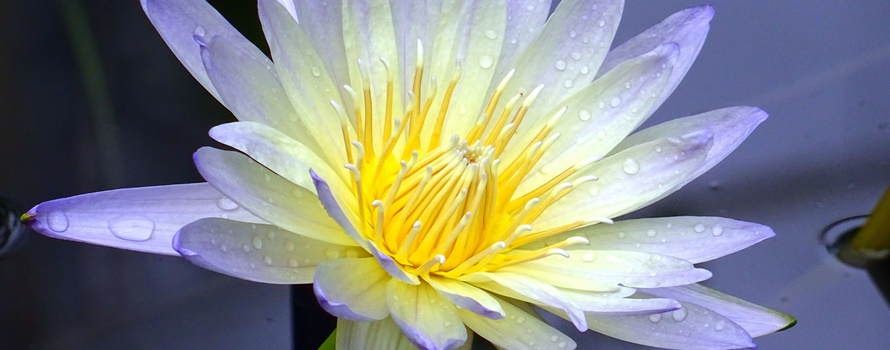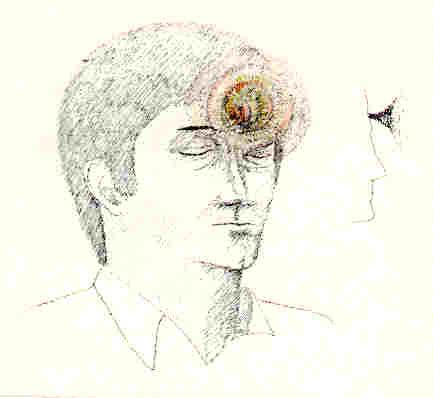Theosophic Description of Chakras
What is a chakra?
A chakra is an energetic center, which is interpreted in different ways according to the corresponding esoteric stream. There are the following interpretations:
-
chakras are vortices of etheric substance only, which take form due to the interaction of energy currents inside and on the surface of the etheric body (similar to convection currents)
-
chakras are etheric energy centers with enormous influence on health and well-being of the person; this interpretation applies to various streams of spiritual healing
-
chakras are astral energy centers, through which the person can connect to transcendental, cosmic qualities
-
chakras are energy centers with magical qualities, that endow the person with special abilities
The interpretations do not always exclude each other, so that the term is quite unclear and vague in many aspects.
In Indian tradition, there are seven main chakras:
In their ‘secret teachings’, the theosophs added a lot of chakras to these traditional ones. The spleen chakra may be more or less the same as the Svadishtana Chakra. From the other traditional chakras, the palatal chakra (source of Amrita = nectar) has no great importance. The theosophs distinguish three different chakras in the forehead region: the Ajna Chakra, the Forehead Chakra and another small chakra above the Forehead Chakra (see article Other Chakras).
Description of the chakras
In his book "The Chakras", C. W. Leadbeater describes the chakras as connection points between the various vehicles (bodies) of the human being, whereat energy can flow between the different bodies through these chakras. They have the appearance of vortices or saucer-like depressions, similar to a convulvulus flower (bindweed), and are located on the surface of the etheric body. The stems of these vortices root in the spine, which can be seen as the "central stem". When being developed, they increase in brightness and size (cf. C. W. Leadbeater: The Chakras. The Alchemists Furnace, 2006, p. 18).
"Lesson with Guru Ananda: The whole thoracic area was very vitalised, and to my astonishment, I was already able to control the energies quite well. The waves only flew into the Anahata. In the last part of the lesson, I even dared to stimulate my Forehead Chakra. During the Mauna (sitting in silence), I suddenly saw the following image in the center between my eyebrows: from the middle of the forehead, a kind of tube protruded, as thick as a pencil. The diameter of this tube increased very strongly with growing distance from the forehead. Its form could be compared to a totally symmetrical chanterelle. Only that its dimensions were a bit larger, so that, at a distance of about five centimeters from the forehead, the diameter was nearly as broad as the forehead. From this outer part of the tube on, I could only see a vague haze that vanished completely at a certain distance. The funnel was bright and nearly colourless. It was only shimmering in a very delicate orange-yellowish tone, mixed with a bright blue." (S.)
Forehead Chakra vision of S.
Number of "Petals" and Chakra Colours
According to Indian teachings, every chakra is associated with a certain number of petals. Own experiences and experiences from friends and acquaintances showed that this number of petals is likely to be linked with the frequency of vibrations of the corresponding chakra – with higher frequency, the location of the energetic center lies at a higher point of the spine.
"I practised in my armchair, with my headphones, and listened to music of Deuter. With the help of this music, I achieved a very good energetic state. I felt energy waves in my whole body with exception of my head. Then I changed the audio cassette and listened to ‘Psalm of David’. With this, I went into a wonderful bhakta state. In this state, I didn’t feel waves anymore and wasn’t focused on a particular body region as well. Then suddenly, I saw a static wheel on a bright background. It had countless, very fine spokes, that slowly vanished at the edges of the wheel." (R.)
Comment: The picture described in this experience is very similar to Leadbeater’s descriptions and picture of the Sahasrara Chakra, with exception of the golden, twelve-petaled chakra that Leadbeater describes as being located at the centre of the Sahasrara.
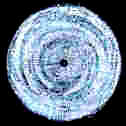
The orthodox Indian chakra pictures are not depictions of chakra images seen in trance, but they are yantras – that is, meditation images with symbolic elements. The colour of the inner area of such a yantra is the symbolic colour of the elements which are associated to the respective chakras. The number of petals is determined by the number of letters in the Sanskrit alphabet (49). Every letter expresses a mantric (shabd) component of the creation (force). To each chakra there is associated a different set and number of letters. This reminds a bit of the 72 names of God in the Kabbalah. Corresponding to the Sanskrit alphabet, Leadbeater’s Ajna Chakra has 98 petals (2x49) and the Sahasrara Chakra has 980 (20x49).
Only since the chakras have stirred the interest of Western culture, they were depicted not in a symbolic way but in the form how they were seen – due to the analytic way of thinking of this civilisation. One of the first people to come up with such pictures was C. W. Leadbeater. The chakra visions of the yogis of the Ashram Ananda were quite close to the depictions of Leadbeater – with exception of the number of petals.
In his monograph "The Aura", Leadbeater pointed out repeatedly how difficult and maybe impossible it is to depict the auric structure in normal printing inks – even less when taking into consideration that this structure is moving and also changing continuously, with very bright, partly shimmering colours. Of course, the same applies to the chakras. However, seen on a monitor, at least their luminosity is closer to the reality than in a book. So far as possible, some of our chakra visions have been drawn; you can see them in the article "chakra visions".
Regarding the colour – there could be observed a general trend in accordance with Leadbeater: the higher the chakras are located, the more their colour shifts to the shorter wavelengths of the visible spectrum – that means: when the energetic focus lies in the lowest area (Muladhara), the colour is red, and, according to the rainbow colours, the colour changes to yellow/ orange (Anahata) and to blue-white (Sahasrara). The white is rather brightness than colour; it occurs because of the strong luminosity of the higher chakras.
On chakra frequencies/ vibes
In dogmatic yoga, every chakra is associated with a certain colour, a certain tone and a certain number of petals. I had read a bit about this dogmatic belief before and considered it nonsense. However, behind these dogmatic or symbolic descriptions lies a real principle. I experienced this for a couple of times, and it was especially noticeable in the following experience:
"… and I could feel very clearly how this energization proceeded from chakra to chakra. Firstly, it was only perceivable in one chakra (at the spine, not in the Medha Nadi on my front side), then the sensation of energization increased up to a very high level, until this enormously strong pulsing simply "slid" up to the next chakra (so, I think, the energy had to be intensified and refined before it could climb upwards to the next chakra). This process went up to the Anahata, but then it sank down again. I thought it had been my fault and tried to keep more still this time. I fully concentrated on the energization again. This time it went faster, and what really was new to me was that I could hear a certain and subtle tone ringing to each chakra. It wasn’t really a tone but rather a high frequency which mingled with the roaring of the energy, and I could hear exactly how the frequency increased abruptly when the energy reached a higher chakra. I never have heard such a "tone change". I knew that there was something like this, but I never experienced it before. And I could clearly sense every chakra as a kind of fast rotating vortex – the higher the chakra, the faster this rotation was. This time, Kundalini worked herself up towards the crown chakra and when she reached it, I heard a very high frequency. I kept still and felt as if my scull would break open at any moment and I thought I would be thrown out into outer space. But then, suddenly, I heard a voice in my head: ‘No, or your head will get broken!’ And instantly, I flung back into my physical body."
Several things can be observed in this particular experience: firstly, I clearly experienced the chakras as vortices. Secondly, there was a certain tone corresponding to each chakra, with frequency ascending. And then, every chakra vortex was rotating with a certain velocity, and this velocity of rotation was ascending as well. So I reconsidered the symbolics I had read about before: it seems that the number of petals in dogmatic yoga correspond with an increasing velocity of rotation. Maybe this could also be the case with the colours (from the modern "rainbow theory" of chakras) and tones associated with each chakra: low frequency to high frequency in tones – long wave radiation to short wave radiation in colours. The colours and tones seem to me like a "physical translation" of the energetic happenings. But this is not everything: the higher frequencies corresponded to a higher state as well; the intensity of energy and the euphoric state was intensifying with each chakra – with each frequency of tones and velocity of rotations. I believe that everyone has his own way of perception, but I think many people have experienced something like this as well thousands of years before. The frequency of chakras seems like a part of a "subtle physics". (Corra)
Chakra Tradition and Knowledge
The most detailed old chakra reports are from India. This knowledge and its implementation in meditations were an important part in Yoga and Tibetic Buddhism. This old traditional knowledge was brought near to the Western culture mainly through the writings of the theosophists Avalon (John Woodroffe) and C. W. Leadbeater.
In Western literature, reports about chakras from times before the theosophists are very rare. But they exist and are a valuable hint that chakras were also seen in other cultures – thus, it is a result of an objective perception (no matter if they are interpreted in a psychological or esoteric way).
The chakra depictions of Gichtel are one of these rare hints. Gichtel can hardly be found in esoteric literature, which is why these pictures possess a certain scarcity value. Johann Georg Gichtel was a disciple of Jakob Böhme. In the year 1638, he wrote a script with the following title: ‘A Brief Revelation and Instruction on the Three Principles and Worlds in Man, how the author has found them inside of himself with divine sight and how he senses, tastes and feels them’.
Chakras of the Etheric Body and how they develop
After this interpretation, chakras are structures of the etheric body, caused by etheric currents or charges. These phenomena of movement follow physical fluid dynamics – which is quite interesting, because the ether is not a physical but a subtle matter. Maybe it is due to its density that it follows physical rules, or it is a physical, unresolved phenomenon. We can’t say that for sure. Ectoplasm obeys these rules as well and flows downwards, following gravity – this can be heard in many seánce reports and was also observed in our Ashram. More informations about ether and the different speculations you can find in the article substance ether.
Below, I will present some observations and try to explain them:
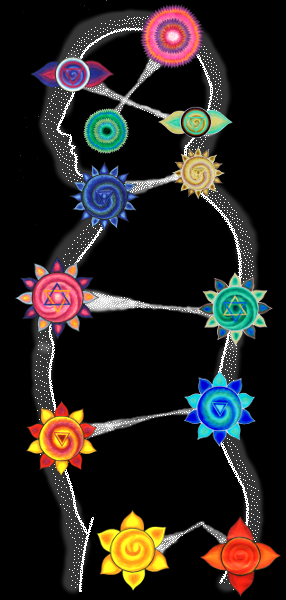
Every chakra has an opposite chakra connected to it
Form of the etheric chakra funnels
The funnel vortices which develop can have different widths and depths.

Strong and weak vortex formation
Structures within the etheric chakras
Circular waves (rings) – Could be caused by vibrations of the kind that are often observed in pre-OBE-states. Another possibility are
Spirals (‘petals’, ‘spokes’) – in a rotating chakra, spirals develop when luminous fluidal flows outwards (caused by Kundalini stimulation), or when there are waves on the surface of the chakra that flow into the funnel. It’s the same effect as when you produce waves in your bathtub and then pull the stopper. In the funnel where the water flows out, rotating spirals will form.
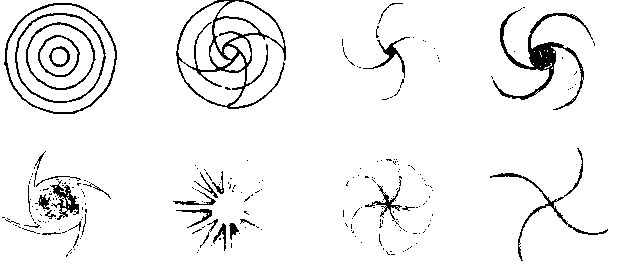
Development of the Chakras
Energy amount and quality
The energy quality is more important than the amount of energy. This quality is not determined by a chakra – quite the contrary: the chakra adopts the quality of energy which is dominating. When working with a particular chakra, the yogi attempts to transform the dominating energy in a way that it slowly adopts the quality that it should have in relation to this chakra (= the ‘true nature’ which can unfold in this chakra). This means, development of chakras is a continuous transformation of energy; an energy is not automatically transformed when flowing into or through a certain chakra (to be honest, that would be a bit too easy, wouldn’t it?). Furthermore, it is not simply a question of working with energies but of working on one’s character. Refining energies has a lot to do with evolution of the personality.
More detailed information on chakras you may find here: Kheper
© Alfred Ballabene (Vienna) translated by Corra

